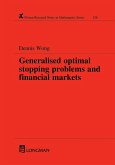Introduction to Financial Mathematics (eBook, PDF)


Alle Infos zum eBook verschenken

Introduction to Financial Mathematics (eBook, PDF)
- Format: PDF
- Merkliste
- Auf die Merkliste
- Bewerten Bewerten
- Teilen
- Produkt teilen
- Produkterinnerung
- Produkterinnerung

Hier können Sie sich einloggen

Bitte loggen Sie sich zunächst in Ihr Kundenkonto ein oder registrieren Sie sich bei bücher.de, um das eBook-Abo tolino select nutzen zu können.
Introduction to Financial Mathematics motivates students through a discussion of personal finances and portfolio management. The book covers nearly all of the syllabus topics of the Financial Mathematics Actuarial examination to provide students with the foundation they require for future studies and in their careers. It begins by covering standard material on the mathematics of interest and goes on to address probabilistic financial models and the valuation of financial derivatives. Many of the examples in the book involve numerical solution of complicated non-linear equations; others ask…mehr
- Geräte: PC
- mit Kopierschutz
- eBook Hilfe
![Introduction to Financial Mathematics (eBook, PDF) Introduction to Financial Mathematics (eBook, PDF)]() Kevin J. HastingsIntroduction to Financial Mathematics (eBook, PDF)88,95 €
Kevin J. HastingsIntroduction to Financial Mathematics (eBook, PDF)88,95 €![Introduction to Financial Mathematics (eBook, ePUB) Introduction to Financial Mathematics (eBook, ePUB)]() Kevin J. HastingsIntroduction to Financial Mathematics (eBook, ePUB)101,95 €
Kevin J. HastingsIntroduction to Financial Mathematics (eBook, ePUB)101,95 €![Introduction to Financial Mathematics (eBook, ePUB) Introduction to Financial Mathematics (eBook, ePUB)]() Kevin J. HastingsIntroduction to Financial Mathematics (eBook, ePUB)88,95 €
Kevin J. HastingsIntroduction to Financial Mathematics (eBook, ePUB)88,95 €![Your Essential Guide to Quantitative Hedge Fund Investing (eBook, PDF) Your Essential Guide to Quantitative Hedge Fund Investing (eBook, PDF)]() Marat MolybogaYour Essential Guide to Quantitative Hedge Fund Investing (eBook, PDF)51,95 €
Marat MolybogaYour Essential Guide to Quantitative Hedge Fund Investing (eBook, PDF)51,95 €![Generalized Optimal Stopping Problems and Financial Markets (eBook, PDF) Generalized Optimal Stopping Problems and Financial Markets (eBook, PDF)]() Dennis WongGeneralized Optimal Stopping Problems and Financial Markets (eBook, PDF)51,95 €
Dennis WongGeneralized Optimal Stopping Problems and Financial Markets (eBook, PDF)51,95 €![Quantitative Finance (eBook, PDF) Quantitative Finance (eBook, PDF)]() Erik SchloglQuantitative Finance (eBook, PDF)91,95 €
Erik SchloglQuantitative Finance (eBook, PDF)91,95 €![An Introduction to Stochastic Processes with Applications to Biology (eBook, PDF) An Introduction to Stochastic Processes with Applications to Biology (eBook, PDF)]() Linda J. S. AllenAn Introduction to Stochastic Processes with Applications to Biology (eBook, PDF)69,95 €
Linda J. S. AllenAn Introduction to Stochastic Processes with Applications to Biology (eBook, PDF)69,95 €-
-
- -21%11
Dieser Download kann aus rechtlichen Gründen nur mit Rechnungsadresse in A, B, BG, CY, CZ, D, DK, EW, E, FIN, F, GR, HR, H, IRL, I, LT, L, LR, M, NL, PL, P, R, S, SLO, SK ausgeliefert werden.
- Produktdetails
- Verlag: Taylor & Francis eBooks
- Seitenzahl: 421
- Erscheinungstermin: 28. Oktober 2015
- Englisch
- ISBN-13: 9781498723916
- Artikelnr.: 57073233
- Verlag: Taylor & Francis eBooks
- Seitenzahl: 421
- Erscheinungstermin: 28. Oktober 2015
- Englisch
- ISBN-13: 9781498723916
- Artikelnr.: 57073233
- Herstellerkennzeichnung Die Herstellerinformationen sind derzeit nicht verfügbar.
Introduction to Probability with Mathematica, 2nd ed., Chapman & Hall/CRC Press, 2009.
Introduction to the Mathematics of Operations Research with Mathematica, 2nd edition, Taylor & Francis/Marcel Dekker, 2006.
Introduction to Probability with Mathematica. CRC Press/Chapman & Hall, November, 2000. Also issued electronically.
Preface xi
1 Theory of Interest
1.1 Rate of Return and Present Value
1.2 Compound Interest
1.2.1 Geometric Sequences and Series
1.2.2 Compound Interest
1.2.3 Discounting
1.2.4 Present Value and Net Present Value
1.3 Annuities
1.3.1 Ordinary Annuities
1.3.2 Annuities Due
1.3.3 Variations on Annuities
1.4 Loans
1.4.1 Loan Payments
1.4.2 Loan Amortization
1.4.3 Retrospective and Prospective Forms for Outstanding
Balance
1.4.4 Sinking Fund Loan Repayment
1.5 Measuring Rate of Return
1.5.1 Internal Rate of Return on a Transaction
1.5.2 Approximate Dollar-Weighted Rate of Return
1.5.3 Time-Weighted Rate of Return
1.6 Continuous Time Interest Theory
1.6.1 Continuous Compounding: Effective Rate and Present
Value
1.6.2 Force of Interest
1.6.3 Continuous Annuities
1.6.4 Continuous Loans3
2 Bonds
2.1 Bond Valuation
2.1.1 Bond Value at Issue Date
2.1.2 Bond Value at Coupon Date
2.1.3 Recursive Approach: Bond Amortization Table
2.2 More on Bonds
2.2.1 Value of a Bond between Coupons
2.2.2 Callable and Putable Bonds
2.2.3 Bond Duration
2.3 Term Structure of Interest Rates
2.3.1 Spot Rates, STRIPS, and Yield to Maturity
2.3.2 Forward Rates and Spot Rates
3 Discrete Probability for Finance
3.1 Sample Spaces and Probability Measures
3.1.1 Counting Rules
3.1.2 Probability Models
3.1.3 More Properties of Probability
3.2 Random Variables and Distributions
3.2.1 Cumulative Distribution Functions
3.2.2 Random Vectors and Joint Distributions
3.3 Discrete Expectation
3.3.1 Mean
3.3.2 Variance
3.3.3 Chebyshev's Inequality
3.3.4 Expectation for Multiple Random Variables
3.4 Conditional Probability
3.4.1 Fundamental Ideas
3.4.2 Conditional Distributions of Random Variables
3.4.3 Conditional Expectation
3.5 Independence and Dependence
3.5.1 Independent Events
3.5.2 Independent Random Variables
3.5.3 Dependence: Covariance and Correlation
3.6 Estimation
3.6.1 The Sample Mean
3.6.2 Sample Variance, Covariance, and Correlation
4 Portfolio Theory
4.1 Portfolios of Risky Assets
4.1.1 Some Practical Background
4.1.2 Stock Transactions
4.1.3 Asset Rates of Return: Modeling and Estimation
4.1.4 Portfolio Rate of Return
4.1.5 Risk Aversion
4.2 Optimal Portfolio Selection
4.2.1 Two-Asset Problems
4.3 Multiple-Assets and Portfolio Separation
4.3.1 Market Portfolio
5 Valuation of Derivatives
5.1 Basic Terminology and Ideas
5.1.1 Derivative Assets
5.1.2 Arbitrage
5.1.3 Arbitrage Valuation of Futures
5.2 Single-Period Options
5.2.1 Pricing Strategies
5.2.2 Put-Call Parity
5.2.3 Delta-Hedging
5.3 Multiple-Period Options
5.3.1 Martingale Valuation
5.3.2 Valuation by Chaining
6 Additional Topics 335
6.1 Valuation of Exotic Options and Simulation
6.1.1 American Options
6.1.2 Barrier Options
6.1.3 Asian Options
6.1.4 Approximate Valuation by Simulation
6.2 Swaps
6.2.1 Interest Rate Swaps
6.2.2 Commodity Swaps
6.2.3 Currency Swaps
6.3 Value-at-Risk
6.3.1 Computing VaR for Individual Assets and Portfolios
6.3.2 Conditional Value-at-Risk
6.3.3 Simulation Approximations
Appendix A Short Answers to Selected Exercises
Bibliography
Index
Preface xi
1 Theory of Interest
1.1 Rate of Return and Present Value
1.2 Compound Interest
1.2.1 Geometric Sequences and Series
1.2.2 Compound Interest
1.2.3 Discounting
1.2.4 Present Value and Net Present Value
1.3 Annuities
1.3.1 Ordinary Annuities
1.3.2 Annuities Due
1.3.3 Variations on Annuities
1.4 Loans
1.4.1 Loan Payments
1.4.2 Loan Amortization
1.4.3 Retrospective and Prospective Forms for Outstanding
Balance
1.4.4 Sinking Fund Loan Repayment
1.5 Measuring Rate of Return
1.5.1 Internal Rate of Return on a Transaction
1.5.2 Approximate Dollar-Weighted Rate of Return
1.5.3 Time-Weighted Rate of Return
1.6 Continuous Time Interest Theory
1.6.1 Continuous Compounding: Effective Rate and Present
Value
1.6.2 Force of Interest
1.6.3 Continuous Annuities
1.6.4 Continuous Loans3
2 Bonds
2.1 Bond Valuation
2.1.1 Bond Value at Issue Date
2.1.2 Bond Value at Coupon Date
2.1.3 Recursive Approach: Bond Amortization Table
2.2 More on Bonds
2.2.1 Value of a Bond between Coupons
2.2.2 Callable and Putable Bonds
2.2.3 Bond Duration
2.3 Term Structure of Interest Rates
2.3.1 Spot Rates, STRIPS, and Yield to Maturity
2.3.2 Forward Rates and Spot Rates
3 Discrete Probability for Finance
3.1 Sample Spaces and Probability Measures
3.1.1 Counting Rules
3.1.2 Probability Models
3.1.3 More Properties of Probability
3.2 Random Variables and Distributions
3.2.1 Cumulative Distribution Functions
3.2.2 Random Vectors and Joint Distributions
3.3 Discrete Expectation
3.3.1 Mean
3.3.2 Variance
3.3.3 Chebyshev's Inequality
3.3.4 Expectation for Multiple Random Variables
3.4 Conditional Probability
3.4.1 Fundamental Ideas
3.4.2 Conditional Distributions of Random Variables
3.4.3 Conditional Expectation
3.5 Independence and Dependence
3.5.1 Independent Events
3.5.2 Independent Random Variables
3.5.3 Dependence: Covariance and Correlation
3.6 Estimation
3.6.1 The Sample Mean
3.6.2 Sample Variance, Covariance, and Correlation
4 Portfolio Theory
4.1 Portfolios of Risky Assets
4.1.1 Some Practical Background
4.1.2 Stock Transactions
4.1.3 Asset Rates of Return: Modeling and Estimation
4.1.4 Portfolio Rate of Return
4.1.5 Risk Aversion
4.2 Optimal Portfolio Selection
4.2.1 Two-Asset Problems
4.3 Multiple-Assets and Portfolio Separation
4.3.1 Market Portfolio
5 Valuation of Derivatives
5.1 Basic Terminology and Ideas
5.1.1 Derivative Assets
5.1.2 Arbitrage
5.1.3 Arbitrage Valuation of Futures
5.2 Single-Period Options
5.2.1 Pricing Strategies
5.2.2 Put-Call Parity
5.2.3 Delta-Hedging
5.3 Multiple-Period Options
5.3.1 Martingale Valuation
5.3.2 Valuation by Chaining
6 Additional Topics 335
6.1 Valuation of Exotic Options and Simulation
6.1.1 American Options
6.1.2 Barrier Options
6.1.3 Asian Options
6.1.4 Approximate Valuation by Simulation
6.2 Swaps
6.2.1 Interest Rate Swaps
6.2.2 Commodity Swaps
6.2.3 Currency Swaps
6.3 Value-at-Risk
6.3.1 Computing VaR for Individual Assets and Portfolios
6.3.2 Conditional Value-at-Risk
6.3.3 Simulation Approximations
Appendix A Short Answers to Selected Exercises
Bibliography
Index







